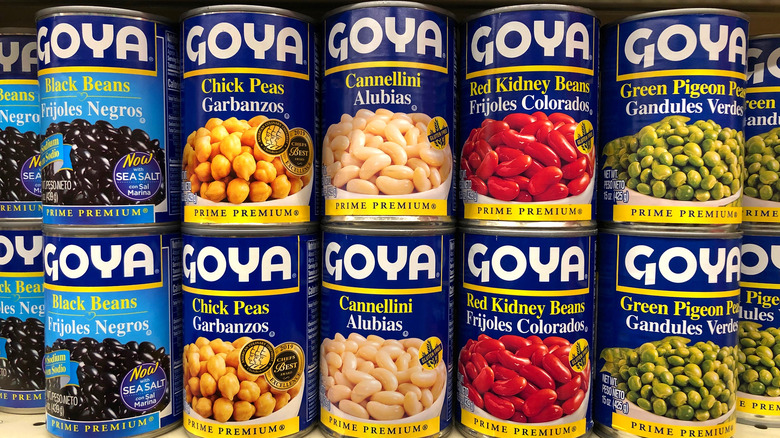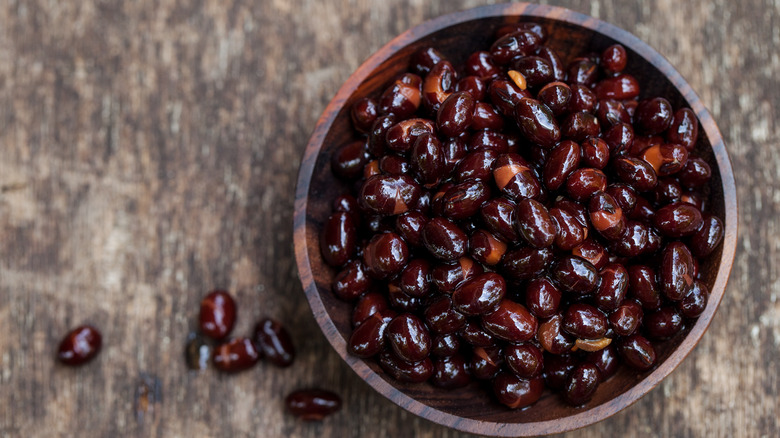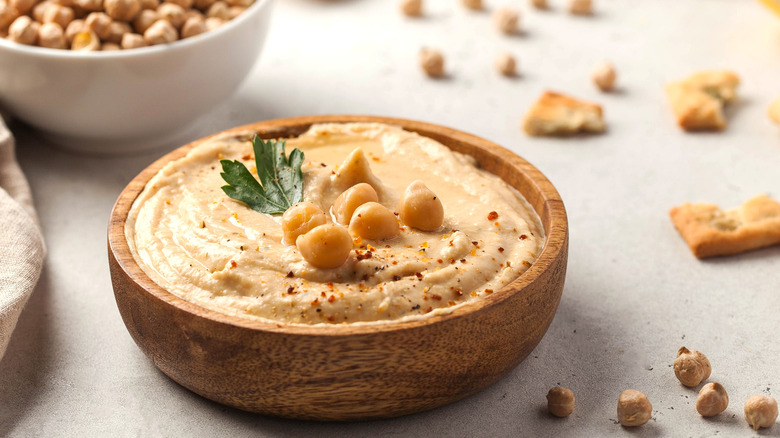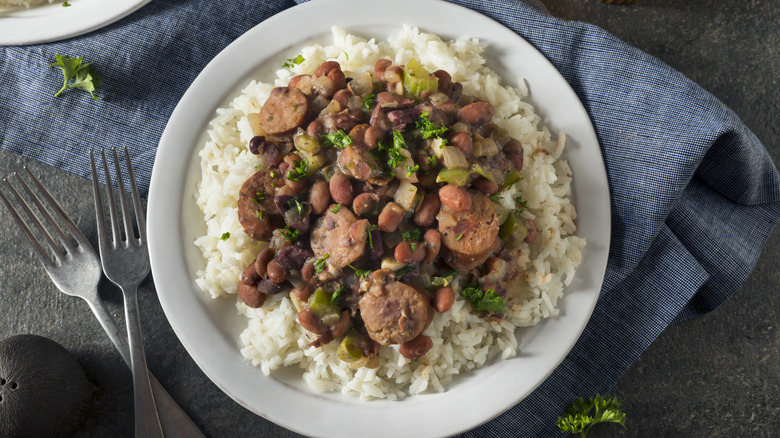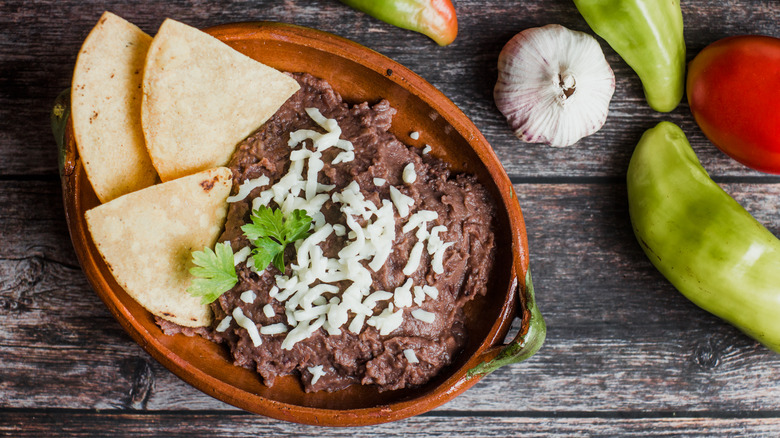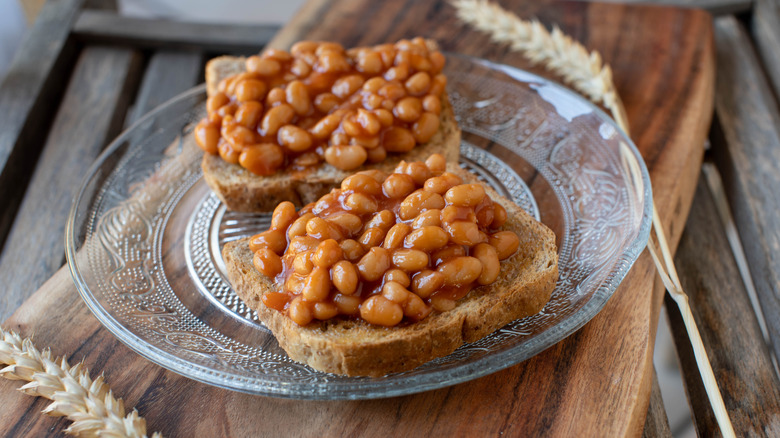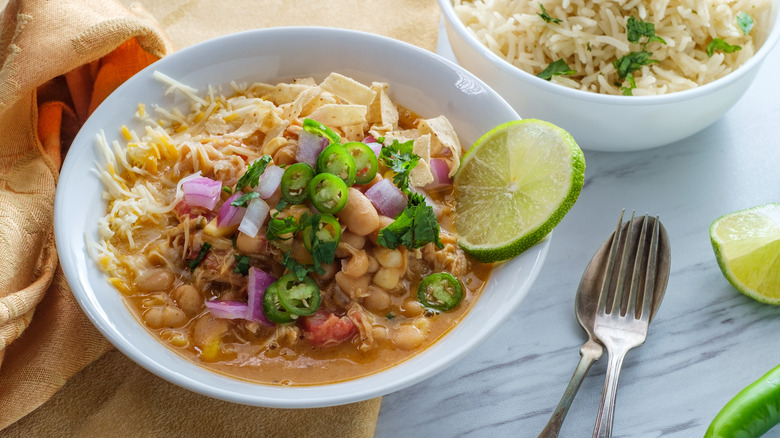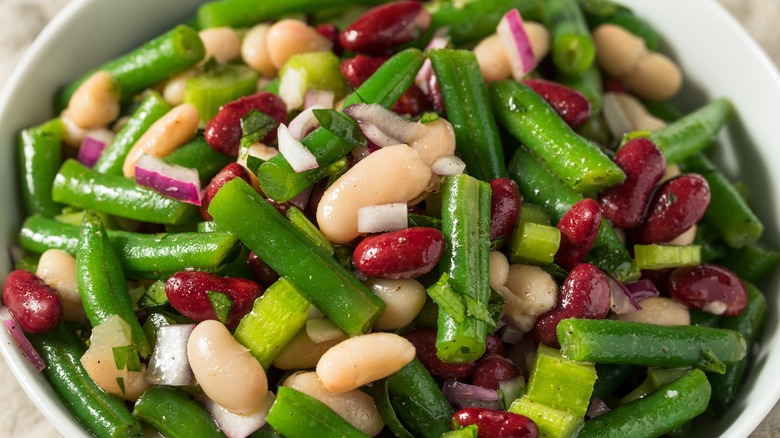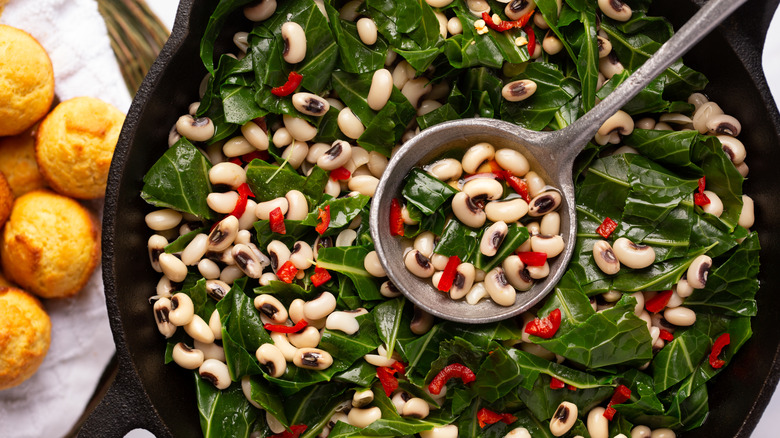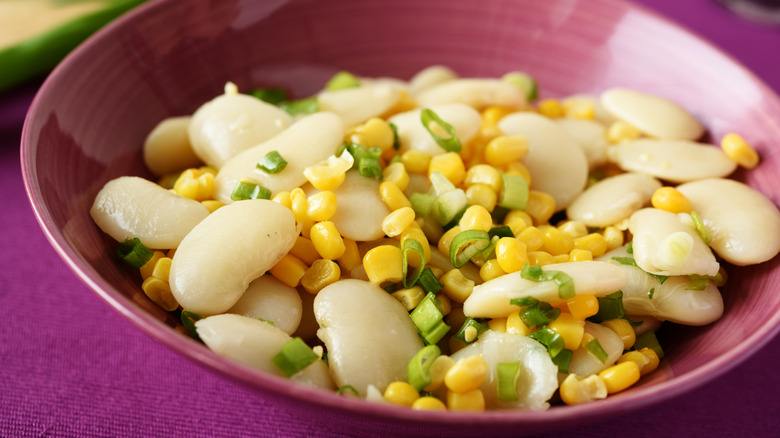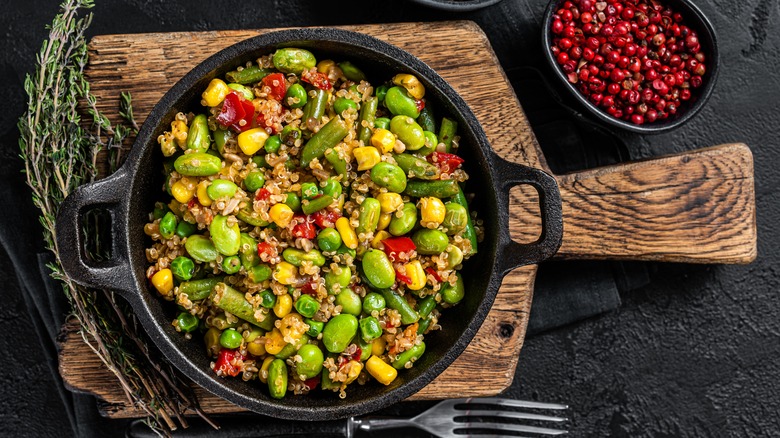10 Canned Beans You Should Always Have On Hand
The saying goes, "Beans, beans, the magical fruit: The more you eat the more you toot!" In fact, per the Bean Institute, the more you eat, the greater your gut health, making you less likely to develop a case of the toots. But seriously, beans are considered to be one of the healthiest and most beloved foods available (via MasterClass). They are widely consumed by cultures around the planet because of their affordability and the fact that they have a long shelf life. When dried and stored in an airtight container in a cool, dry place away from sunlight, they will last for years.
According to Healthine, beans and legumes, which are the fruits or seeds of the Fabaceae plant family, are loaded with fiber, protein, iron, magnesium, potassium, zinc, and folate. They are also effective at helping to regulate blood sugar and lower bad cholesterol and are high in resistant starch, which is known to help you feel fuller longer (via WebMD). Beans are magical — but not for the reasons you thought they were.
And while dried beans can be stored for a long time, they do take forever to cook. Therefore, we opt for canned beans, which are a brilliant pantry staple for vegetarians and non-vegetarians alike. We always keep a wide assortment of them on hand for a quick, easy, delicious meal. They are so incredibly versatile that we view them as a kind of palette of paints from which we can create our culinary works of art.
1. Black beans
Black beans, turtle beans, or frijoles negros — whatever you call them, these beans have been eaten for more than 7,000 years, according to WebMD. Native to North America, they are perhaps best known for being a part of the canon of Latin American cuisines. Today, the majority of the world's black beans are grown in Brazil. Aside from the usual litany of health benefits that come with eating beans, black beans in particular are known for being rich in antioxidants related to both the prevention of cancer and, more particularly, reducing the risk of macular degeneration and cataracts.
While we certainly love them as a side dish or the base of a salad, we also enjoy using them in more unusual ways. A favorite recipe is a rich black bean soup which we top with some avocado and queso fresco. It is also a very common base for a vegetarian bean burger thanks to its meaty texture when mashed. And lest you think you can only use them in savory dishes, believe it or not, black beans can effectively be incorporated in baking a vegan cake.
2. Chickpeas or garbanzo beans
According to ThoughtCo., chickpeas or garbanzo beans were cultivated in the Levant in what is now modern-day Turkey and Syria, approximately 11,000 years ago. While wild chickpeas come in two basic varieties known as Desi and Kabuli, 21 different permutations of the chickpea, varying in color and shape, exist. Its domesticated version tends to be heartier and easier to grow year-round. Today, most of the world's supply of chickpeas is produced in India.
Nutritionally, the chickpea is unique in that it is considered a superfood for brain health (via Healthline). It is high in the nutrient choline, which may benefit brain function, particularly among infants. It is also high in magnesium, which has been linked with increased nerve function. And while more research needs to be done, it may be a key to helping mitigate depression and anxiety, thanks to high percentages of nutrients including selenium and zinc.
As for how to use those chickpeas in the kitchen, their utility goes way beyond a classic hummus or falafel. We are somewhat biased because of our penchant for North African cuisine, so we love them in a variety of both meat-based and vegetarian tagines as well as fried and seasoned with spices. And they are our favorite bean to top a salad with thanks to their meaty yet creamy texture.
3. Kidney beans
Kidney beans are a member of a group of beans known as "common beans," which were domesticated around 8,000 years ago in the Americas (via Camellia Brand). These beans represent an important aspect of both the diets of North American indigenous tribes as well as that of colonial populations, including enslaved Africans and immigrants who settled in New Orleans and southern Louisiana. While the popularity of this bean has spread throughout the world, it is still considered very much ubiquitous within Cajun and Creole culinary traditions.
While kidney beans are thought to have many of the same health benefits as other beans, per Healthline, they are unique in that they can actually be highly toxic if undercooked. Not only do they contain a protein called phytohaemagglutinin which has caused death in both animals and humans, but they have several antinutrients, which are responsible for blocking the absorption of nutrients in your gut. For this reason, using canned kidney beans can actually be both a resourceful option and a safe one.
Certainly kidney beans are a great addition to salads as well as a popular bean to use in making homemade chili. They are also the star of a classic New Orleans-style red beans and rice. Do note that kidney beans, along with all canned beans as a general rule of thumb, should be rinsed before being used to wash away the sodium and other additives used in the canning process.
4. Low-fat refried beans
The term "refried," when it comes to beans, is actually a misnomer, per Culinary Lore. The beans are not actually fried twice but rather cooked twice, as their name in Spanish — frijoles refritos — suggests. They cook for the first time after being soaked in water for several hours. The second time they cook, the now-mashed beans are cooked in lard until they are completely devoid of moisture. According to Eden Foods, this process is a relatively recent invention coming out of Northern Mexico and bleeding over into American Tex-Mex cuisine in the early 20th century.
While classic refried beans have a reputation for being incredibly high in saturated fat thanks to being cooked in large quantities of lard, there are some versions that are cooked in healthier fats which can be incorporated as part of a healthy diet (via Healthline). The key is to check the label on your cans of refried beans carefully. You should always opt for variations not cooked in lard, and you should always choose one that has a sodium content of less than 15% of the recommended daily allowance.
As for how to use them? The sky's the limit. Obviously they can be added to virtually any of your favorite Mexican or Tex-Mex dishes. They can also be the base for a fabulous refried bean dip that will be the highlight of any of your Super Bowl festivities.
5. Baked beans
According to the New England Historical Society, the topic of the history of baked beans is a controversial one. While some attribute its origins to the indigenous populations of North America teaching the Puritans how to bake them in clay pots, others insist that baking beans has been a tradition among Jewish populations of North Africa and Spain for far longer. Wherever it came from, Boston became known as the epicenter of baked beans in the United States. Nicknamed Beantown, Boston was the capital of U.S. molasses manufacturing, and their baked bean recipe took generous advantage of said molasses. In 1993, the navy bean became the official Massachusetts state bean after being deemed the original bean featured in the classic Boston baked bean recipe.
While there are numerous brands of canned baked beans, you should keep a few things in mind when deciding upon which one to purchase. Beans themselves may be highly nutritious, but baked beans may not be the healthiest option (via Healthline). Many recipes are high in sugar, high in salt, contain additives, and may be packaged in cans containing the contaminant bisphenol A (BPA), which has been linked to a myriad of health concerns. Fortunately, there are a number of brands on the market that are lower in sodium and sugar, and are packaged in BPA-free cans. It may require a bit of label reading to find these brands, but a good-quality baked bean is an essential item to keep in your pantry.
6. Navy beans
While the navy bean is synonymous with a classic Boston baked bean recipe, its origins date back thousands of years to South America (via Camellia Brand). Its name comes from the fact that during the 19th century, they were a part of the standard rations issued to sailors aboard U.S. Navy warships thanks to their durability, affordability, and high nutritional value.
According to Verywell Fit, along with many of the other health benefits that beans in general confer, navy beans have a couple of distinct qualities making them even more of a nutritional powerhouse. They are distinctly high in lysine, which is critical in developing and sustaining muscle tissue. They also have a substantial quantity of copper in them, which is integral in the body's production of red blood cells necessary for proper circulation.
Fun fact: The navy bean is the star of a dish that has been on the menu of the U.S. Senate every day for over a century, namely Senate Bean Soup, per Atlas Obscura. These beans are also frequently seen as an addition in soups and stews in recipes across the globe, from Hungary to Serbia. One of our personal favorites is a classic pasta e fagioli, where the creamy beans pair beautifully with the hearty broth and noodles. There's no need to use dried beans in this recipe. Canned will work perfectly well and save you a lot of time.
7. Cannellini beans
While the cannellini bean is often considered to be ubiquitous in Italian cuisine, its origins are not too dissimilar to that of a high percentage of beans consumed globally (via Holland & Barrett). The beans are thought to have made their way from Peru to the gardens of Italian immigrants residing in Argentina. These immigrants popularized their use, and now they are widely available throughout Italy.
Like their other white bean cousins — including the navy bean, great northern beans, and baby lima beans or butterbeans — cannellini beans are uniquely high in a myriad of micronutrients, per Healthline. They are a particularly rich source of magnesium, which has been linked to everything from combatting depression to preventing migraines (via Healthine). In fact, magnesium is one of the most important minerals that the majority of us tend to be deficient in. What better way to increase our magnesium levels than to incorporate more cannellini beans into our diet?
Some of our favorite ways to use canned cannellini beans involve swapping them out for other beans in recipes like hummus. Because of their delicate texture, they puree into a dip like a dream. In fact, don't tell the chickpea, but we almost prefer cannellinis in our hummus. We also love these white beans added to a simple tuna salad, where it not only pumps up the nutritional value but really creates a glorious consistency atop a crunchy piece of bread.
8. Black-eyed peas
According to Consumer Reports, black-eyed peas originated in West Africa, but are cultivated across the globe. Also known as cowpeas, goat peas, lubia, and akkerboon, black-eyed peas are popular because not only are they incredibly nutritious, but they actually infuse nitrogen into the soil, essentially fertilizing it for other crops. They are a popular dish served in the American South on New Year's Eve, a tradition that likely was born on December 31, 1862, which is known as Freedom Eve. On this night, while anticipating word of the Emancipation Proclamation, enslaved Africans consumed a dish of cowpeas and rice.
As with other beans, black-eyed peas are rich in fiber, protein, magnesium, zinc, and folate. They are particularly nutrient-dense, making them a fantastic alternative to meat proteins for vegetarians or those seeking to go meatless one or more days a week for either health or economic reasons.
Aside from a classic stew with pork and collard greens, canned black-eyed peas can be used in a myriad of recipes ranging from salads to soups. We love refried black-eyed peas for a tasty side dish to accompany your next Mexican fiesta. It's also a winner in a Southern-spiced spin on hummus, which would be a perfect addition to your next tailgate party.
9. Lima beans
Not unsurprisingly, the lima bean gets its name from Lima, Peru (via WebMD). Also known as a butter bean, this wide, flat, starchy bean has been a staple of human consumption in Peru since as far back as 800 B.C. In accordance with other beans and legumes, lima beans are high in fiber and a tremendous source of micronutrients. However, lima beans do have a couple of unusual qualities that are important to know. They are potentially hazardous if consumed undercooked, thanks to not only anti-nutrients preventing mineral absorption but also the presence of linamarin, which is cyanogenic and potentially dangerous for human consumption (via Healthline). The cooking process neutralizes these substances, so as long as you are consuming them well done, like in canned format, you do not run the risk of any kind of adverse reaction.
Perhaps the most quintessential use for lima beans is in a classic Southern succotash, where it is combined with the bounty of summer vegetables, including corn, okra, and summer squash. However, because of their unique ability to break down when heated, they are a fantastic addition to soups and stews, adding a creaminess without a drop of dairy. One of our favorites is chilled butter bean soup, topped with a peanut and corn relish to accentuate the delicate texture created by the lima beans.
10. Edamame
If you have ever eaten at a sushi restaurant, you have likely eaten steamed edamame out of a shell as an appetizer. While edamame is associated with Japan, it actually originated in China about 2,000 years ago (via Everyday Health). They are essentially a very young soybean, but they differ from what we typically see growing commercially on farms throughout the Midwestern U.S.
According to Healthline, edamame is particularly rich in compounds called Isoflavones, which resemble estrogen. There has been much debate as to the risk or benefit of consuming estrogen-rich foods in terms of their potential to combat or fuel both breast cancer and prostate cancer. They have been anecdotally linked with the mitigation of symptoms associated with menopause in women. Certainly, more studies need to be conducted to determine the accuracy of these claims, but Asian women are purported to suffer from fewer menopausal symptoms, fueling the need for more research.
As far as their utility in recipes is concerned, their mild flavor and delicate texture make them suitable for almost any kind of recipe involving beans. You can substitute them for other beans in salads, stews, stir-fries, or hummus. They also are great in a vegetarian edamame burger paired with other umami-rich ingredients to create a convincing facsimile of meat.
